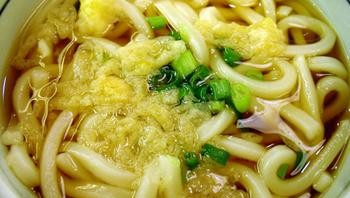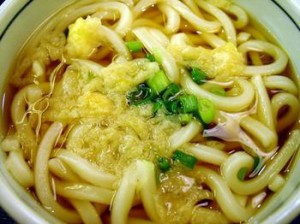
 Udon refers to the thick buckwheat noodles which are generally served hot in a broth. The selection of what you can order to go in the broth is similar for most Japanese noodle dishes. The history of udon noodles spans centuries and continents. Brought with Buddhism from China by Japan’s first priests in the early ninth century, the noodle is believed also to have found its way in the 12th century to Europe, possibly via Marco Polo. The coarse and unrefined appearance of udon buckwheat noodles, in particular, appealed to the ascetic tastes of the Buddhists. One Zen sect temple in Asakusa became so rich and famous for its sale of the udon to Buddhist pilgrims, that in the 1780s it was forbidden to carry on the rich trade. Merchants took over the business and spread the udon blessing among the populace. Udon noodles are delicious and healthy, and if you’re into noddles, see below for my yummy and nutritious Power Udon recipe …
Udon refers to the thick buckwheat noodles which are generally served hot in a broth. The selection of what you can order to go in the broth is similar for most Japanese noodle dishes. The history of udon noodles spans centuries and continents. Brought with Buddhism from China by Japan’s first priests in the early ninth century, the noodle is believed also to have found its way in the 12th century to Europe, possibly via Marco Polo. The coarse and unrefined appearance of udon buckwheat noodles, in particular, appealed to the ascetic tastes of the Buddhists. One Zen sect temple in Asakusa became so rich and famous for its sale of the udon to Buddhist pilgrims, that in the 1780s it was forbidden to carry on the rich trade. Merchants took over the business and spread the udon blessing among the populace. Udon noodles are delicious and healthy, and if you’re into noddles, see below for my yummy and nutritious Power Udon recipe …
What’s in my Power Udon recipe?
One of the healthiest, yummiest and cheapest meals I eat several times a week is my version of a Japanese-inspired udon dish. I call this champurudon.
First, boil some udon noodles + a handful of wakame (seaweed) + a handful of shiitake (mushrooms) until the udon is al dente and the wakame and shiitake are soft and ready to eat. Strain off the water and leave to drain a little.
Next, put the mix into a bowl and add the following: a pinch of salt and pepper (or dashi powder, if you know what it is and have it), a small tin of sardines in vegetable oil (50c – $150 at any supermarket – drain off some of the oil first) and a good teaspoon of sesame seeds sprinkled over the top.
And if you like a little spice, add 1 heaped tablespoon of Korean kim chi (spiced fermented cabbage).
Mix everything loosely and enjoy this simple, highly nutritious meal.
Eat the noodles warm in winter or chilled a little in summer.
I have converted many noodle-Nazis to noodles with this recipe!
